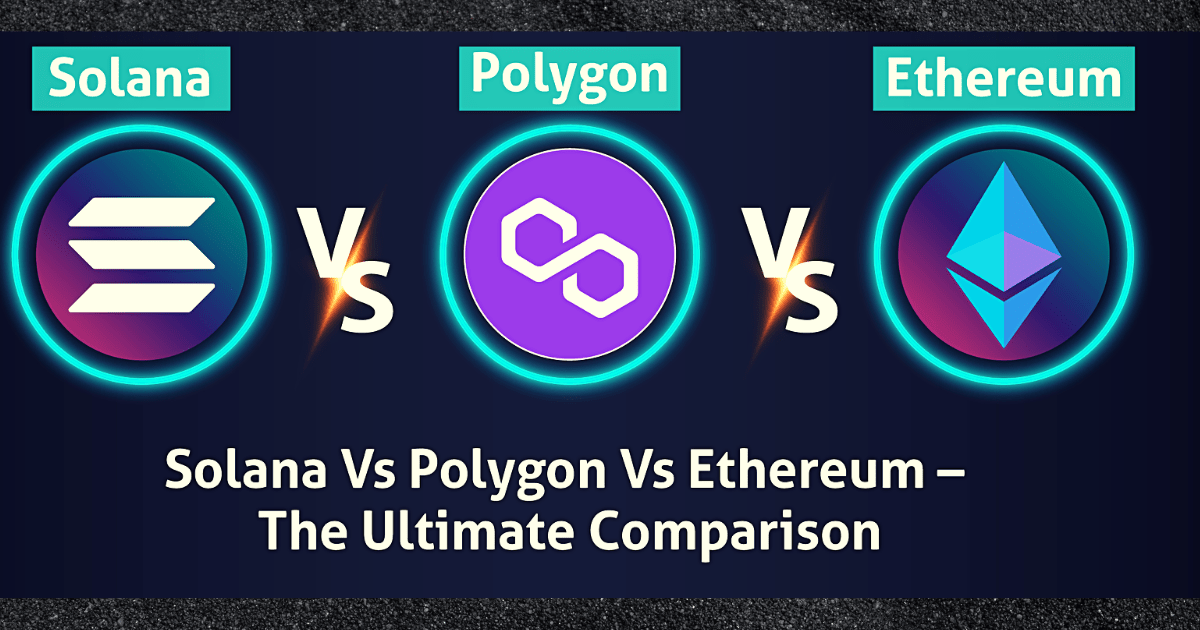Blockchain innovation is one of the most discussed advancements on the planet at the present time. With the section of blockchain, various sorts of uses were likewise created for these portions.
It has entered every fragment, bringing its decentralized framework for enhancements over the current advances. With the section of blockchain, various sorts of uses were likewise created for these portions. These applications depend on a specific blockchain stage, out of which the most noticeable are Ethereum, Solana, and Polygon.
While Ethereum has been one of the most seasoned and most utilized blockchain stages, Polygon and Solana have been the new players on the lookout, giving quicker and better exchanges to the clients.
The application stages work regardless of their worth👇
One of the significant confusions that individuals have, particularly the people who are new to this, is that the blockchain stage’s presentation is worth it has while exchanging. Most important, the data is misleading.
Before you get to a blockchain stage to make your applications on, be guaranteed that the worth doesn’t influence it. Upsides of the digital currency are implied for exchanging alone. Ethereum is the most enhanced stage in terms of blockchain application improvement.
With Ethereum 2.0, it has a greater number of elements and enhancements than some other contenders. Ethereum began a market where blockchain stages were utilized for NFTs and brilliant agreements. It prompted the further extension of the market and prompted the introduction of contenders like Polygon and Solana.
While Solana gives significant contest to the Ethereum stage, Polygon is behind it. Solana gives a lot quicker exchanges at a diminished expense when contrasted with Ethereum and Polygon, while Polygon gives quicker exchange speeds. While the Ethereum stage is more about the highlights and security, Solana and Polygon are more about reasonable rates, quicker velocities, and adaptability. Before investigating the distinction between the three, we should examine what the three blockchain stages are.
Ethereum 👉
We definitely know that the most famous blockchain stage on the planet is Bitcoin. Ethereum comes in runner-up and is one of the most preferred blockchain stages for making decentralized applications. Ethereum has been liable for making an open economy by giving its own digital money and stage for creating decentralized applications.
The stage can get to by anybody paying little mind to the area and foundation. There is a strength of Ethereum with regards to the market of computerized collectibles as it has been the principal stage that gave away to NFTs. Because of this, designers have been involving it as the principal inclination for making computerized resources. The main imperfection you can depend on here is the stage’s escalated registering power.
Highlights-
- Advancement and Deployment of brilliant agreements. Truth be told the Ethereum stage was the foundation of making NFTs and Smart agreements.
- It utilizes the Ethereum Virtual machine that gets the agreements and permits clients to cooperate with them.
- it permits the clients to make merged applications, which are decentralized applications.
- Ether is the computerized badge of Ethereum, which can likewise acquire as a prize.
- It empowers the clients to make popularity-based decision-production with complete straightforwardness.
Geniuses-
🥇Ethereum has more accentuation on elements and upgrades, which makes it one of the most outstanding blockchain applications.
🥈The blockchain seldom goes through any issue and is one of the most steady and proficient blockchain stages accessible.
🥉It accompanies a Stateful design which improves it for application advancement.
Cons-
- Needs a ton of handling power; so, there is less extent of association of diggers.
- Because of the great necessity of assets, the exhibition incurs significant damage.
- Less exchange handling speed.
Solana 👉
Solana is without a doubt an extraordinary contender to Ethereum. The stage made to give designers a spot to foster client arranged applications. The most captivating element of the stage is its effectiveness. Solana is known to process around 50,000 to 65,000 exchanges, making it one of the quickest blockchain stages accessible.
It is at present the speediest blockchain stage accessible to designers for making adaptable applications and because of this, it has the most productive biological system. The significant focal point of Solana is on versatility and easy-to-use application, which settles on thinking about a new blockchain stage separated from Ethereum. It right now has more than 400 Defi, Web3, and NFTs. It manages up to 3,000 exchanges per second to go up to 65,000 exchanges in a moment.
Highlights-
- The blockchain model work on the agreement idea of PoH (Proof of History) for permitting and confining passages in the data set
- It involves the Gulfstream framework for the exchange to stand by in memory pool until their chance for handling up. It holds up to 1,00,00 exchanges all at once.
- It can empower many savvy contracts all the while, which helps in saving expense and time.
- Quick handling of information by utilizing different equipment associated through networks.
- Utilizes different blockchain hubs in more modest bundles for a speedier speed of exchanges.
Experts-
🥇 Follow stateless engineering
🥈 Sped up exchange handling of up to 50,000 exchanges every second
🥉 Elite execution convention for versatility
Cons-
- The equipment support for Solana is costlier in correlation
- Not decentralized enough
Polygon 👉
Polygon is one of the most famous computerized blockchain stages accessible to clients. The stage is answerable for giving advanced resources and economies.
The significant usefulness of Polygon is to empower the multichain Ethereum environment. It gives an organization that offers interoperability among past and present framework situations of Ethereum.
Because of this, it offers extraordinary use and a quick exchange speed of right around 65,000 exchanges each second. It is very well known as a more mixture type of blockchain stage, which organizations the great highlights of Ethereum and Solana.
Highlights-
- Interoperability of components in view of the past and existing engineering of Ethereum
- It is totally viable with Ethereum
- Better execution with an exchange speed of up to 65,000 exchanges each second
- Gives multi-affix engineering better versatility
Stars-
🥇Safer because of the consequences of the approval framework
🥈Polygon is working to scale with the rising volume of exchanges
🥉Gives a comparative encounter to that of Ethereum
Cons
- With improvements in Ethereum 2.0, Polygon won’t be needed as the next layer
The distinction between Polygon, Solana, and Ethereum
We referenced the significant subtleties of all the 3 blockchain stages above, still, as a blockchain application engineer, which one would it be advisable for you to go for.
We will talk about the significant contrast between all the three blockchain stages which makes them appropriate for quite long-time applications.
Agreement-📜
It is one required method that you will find among all the decentralized blockchain stages. It assists with agreeing on the current situation with the organization. What Ethereum follows is PoW or Proof of Work instrument of agreement.
The issue with Ethereum is the necessity of high handling power. Because of this, it doesn’t permit the extension for quite some time to take part in this, despite the fact that it permits diggers worldwide to take part in the agreement.
Since handling power necessity is high, it additionally negatively affects the exhibition but guarantees better security.
With Polygon, you can get an agreement in view of PoS or Proof of Stake. Assuming a client takes on the Polygon organization, they can get awards as Matic was taken. Since it offers a blend of advancements, the agreement can be accomplished more quickly.
Solana then again has a remarkable way to deal with agreement instruments. Since it gives one of the quickest exchange speeds, the system offers productive activity.
It tends to know as a Hybrid type of agreement with the best elements of PoW, PoS, and PoH, which is Proof of History. It considers greater adaptability in arranging exchanges. It is the reason Solana can process up to 65,000 exchanges in a moment.
Exchange Speed⏳
The speed of exchanges on a blockchain stage is one of the main considerations that assists the engineer with concluding the stage they need to chip away at. With regards to exchange speeds, the slowest among them is Ethereum.
Every member in Ethereum has a duplicate. so, the participant will either have to wait for a long time or pay a huge fee for verification. Because of this, a limited number of transactions are processed every second, which can range from 13 to 15.
When it comes to Solana and Polygon, they are way ahead in terms of transaction speeds and offer 50,000-65,000 transactions per second which are a lot faster.
Solana needs to depend on Tower Byzantine Fault Tolerance of TBFT which prevents real-time communication among nodes and reduces the time taken, increasing efficiency. Polygon on the other hand has the fastest speed.
Architecture🖇️
One more important point that the developers consider is the architecture. The architecture defines the state of the blockchain network and if it can change variable values. Ethereum has one of the best stateful architectures among the competition due to which it is used for making apps on the blockchain platform.
The platform admires all the exchanges in the existing state and copies of the recent transactions are immediately coined to mirror the recent transactions. It is a used full network but is slower compared with stateless networks.
Polygon comes with a thought of a borderless society and trade where it works like POS blockchain and exchanges are present in the form of clusters. Solana on based on a cluster architecture that works on Solana clusters. It is a collection of validators that together address the client transactions with ledger maintenance.
Every cluster has carry its own validator and the part of each validator continues to rotate among them. The leader of the cluster will build and timestamp the transaction with PoH consensus. It is a stateless architecture and due to this, the whole state of Solana architecture does not need to update every time. It is why these two Solana and Polygon are very efficient and provide faster transactions.
Scalability📊
It is one of the most critical factors that the developer should look after before selecting a platform for blockchain app development. It makes if the network is scalable to ensure the completion of the exchange.
Along With Ethereum, the exchange speed is 15 transactions per second, which is slow when compared to the competitors. But, the layer 2 scaling with multichain network support resolves the scalability issue. Solana can process 50,000 transactions a second, due to which scalability issues do not exist in it. Polygon offers the same kind of scalability also as Solana with even improved transaction speeds.
Famous projects-
- Ethereum has done projects like Cryptokitty, crypto punks, OpenSea, Rarible, Nifty Gateway, and Decentraland.
- Solana has made projects like Degenerate App AcademySolPunks, Sollamas, Solsea.
- Polygon has done Plasma-Enabled Sidechain, PoS SportX, ZED RUN, Easy Fi, QuickSwap.
Conclusion-
So here is the difference between the 3 most popular blockchain platforms. The usage of all three platforms would depend on the type of applications that will be created.
These blockchain platforms are fast gaining attention in the market due to the kind of application and usability it offers. Also, since the crypto space is booming, we will be looking at a huge increase in the use of these platforms in the future.
Using these platforms, the user can invest their time into Defi and NFTs, which are the biggest trend in the world of blockchain right now. It would be completely the choice of the user on which of the three platforms they want to use for Defi and NFT.







